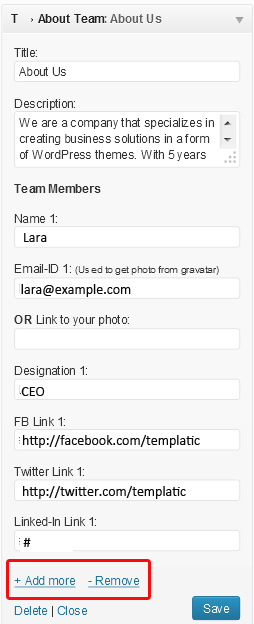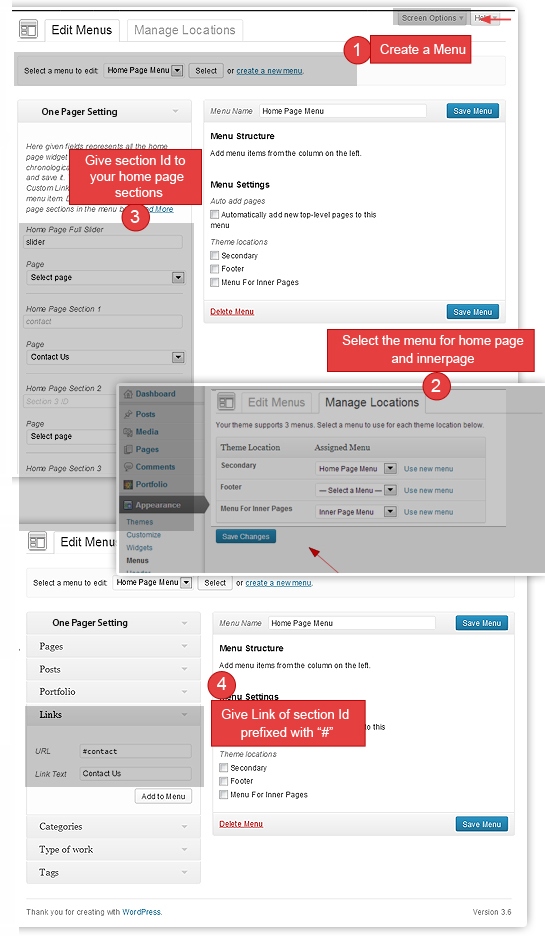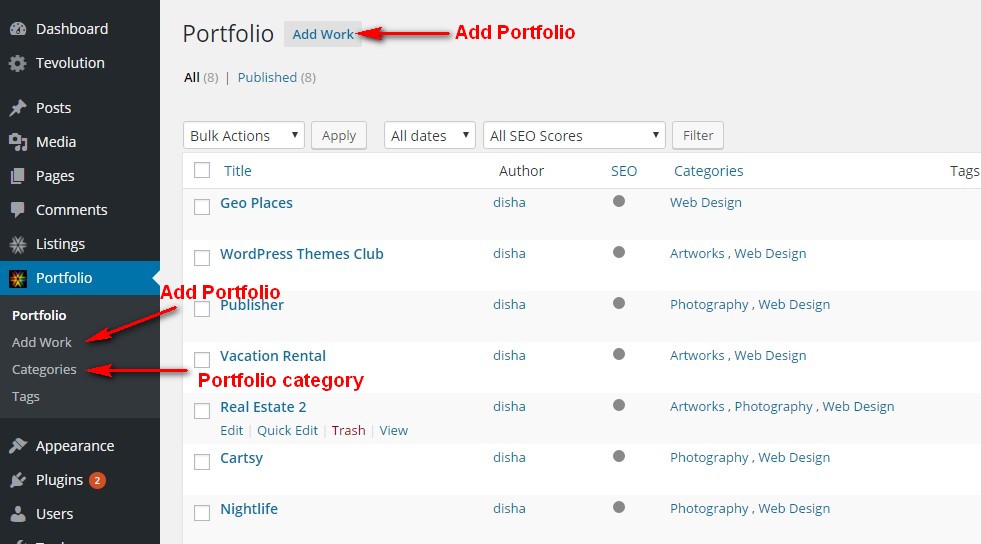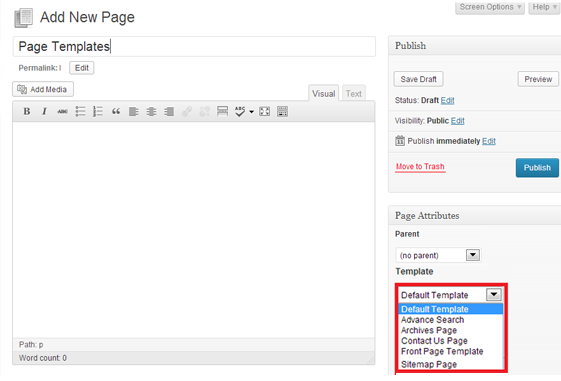Theme Installation
Need help with installing the theme? Hire us!
For more details on this service, please click here!
1. Installing theme with WordPress back end
- Connect to member area and expand the one pager section under My Downloads. Download the theme to your hard drive.
- Connect to your WordPress dashboard (wp-admin) and navigate to Appearance -> Themes. Click on the Install Themes tab and then on Upload. Use the Browse option to locate the one pager zip file on your hard drive – then click on Install Now. After the installation process is finished activate the theme.
2. Install using FTP
- Extract one pager.zip then upload to /wp-content/themes directory
- Once uploading is done connect to the WordPress dashboard and activate the theme
- If you run into more problems during installation please visit our Installation Guide
For detailed instructions on using FTP please click here
Getting Started
1. Insert dummy data
It is not compulsory to insert dummy data but it is advisable to do so because as it sets up the entire sample site for you, you can have over all idea how you would like to build your site and so increases your creativity!
After installing and activating the theme,
- Go to Wp-admin -> Appearance – > Themes
- Click “Insert Sample Data” button to insert the Sample data
- As soon as you click this button, it will change to “Delete Sample Data” to let you delete all the sample data, if you want!
Be cautious, along with sample data, it also deletes all your modifications done using sample data forever.
2. Set your Business logo, Color and other theme options
We will be discussing few of the options from the customization theme options as most of them are quite easy to understand and operate.
Change the Logo
Changing the logo is just a simple process of uploading your own logo image!
- Go to wp-admin->Appearance ->Themes – > Customization
- Click Site Logo section to expand it.
- Click on existing image and load a new one from your hard drive. You can do the same for the favicon icon.
Edit General settings
- Hide autoinstall – checking this will turn off the dummy data activation option inside Appearance -> Themes
- Use custom css – enable this if you want to customize your theme using the custom.css file. The file can be modified from Appearance -> Editor sections. For details on using that file click here
- Enable sticky header menu – makes the header menu show even when scrolling down the page.
- Show author biography on posts – display the authors avatar, name and bio on posts
- Show author biography on pages – display the authors avatar, name and bio on pages
- Show breadcrum – display a navigation trail inside posts and pages (above the title)
Remove/Change the Templatic credit line from the footer
To remove the “Designed by Templatic” credit line inside the footer area, do this:
- In Appearance -> Themes -> Customize
- Click Footer option to expand it
- Now remove the second paragraph inside the section that states the Templatic credit line.
- OR you can also show your credit name and logo instead of “Templatic” by using the example given there just above the text box.
Similarly, you can change all the available theme options given in the “Customization” as per your requirement, including Color (Color change affects your site in real time i.e. you can preview the color before actually applying it to your site).
3. One Pager special menu setup
This theme is specially made to show almost everything on the single page. And to locate the things on this whole page website, you would definitely like to include a menu for it to avoid the lengthy scrolling . So, here is how you can set up such same page links in your menu. Before that, have some idea, how custom menus work in WordPress with this video tutorial.
First of all
- Go to wp-admin -> Appearance -> Menus -> One Pager Settings
- Turn on “One Pager Setting” option from “Screen Options” given at the top of your screen (if you are not able to see this option by default).
The different fields given there represents the home page widget areas by default. It means that Home Page Full Slider field points to the Home Page Slider widget area and likewise the other fields point to all the home page widget areas chronologically. So now, to set up the links in menu bar follow this,
A) Link home page widget areas
- Step 1 – Create menu and select it from Manage Locations -> Secondary
- Step 2 – Add Id (Ids can be numeric, alphanumeric or alphabets, just you cannot add spaces between them)in the fields such as Home Page Full Slider, Home Page Section 1 etc
- Setp 3 – Save them (It is compulsory)
- Setp 4 – Now, write the same Id with prefix “#” in Custom Links field (e.g. #contactpage)
- Setp 5 – Add it to menu and save the menu
- Setp 6 – Likewise add menu links of rest of the sections as per your requirement.
- Setp 7 – Refresh your browser and see the effect.
B) Show any page content on your home page
Suppose, you do not want to show any widget area but any particular page on your home page then,
- Follow the same process as described above but after step 2 , select your desired page from the given drop down “Page”
- Repeat the rest of the steps as above.
Doing this, it will not directly redirect you to your selected page but will show all the content of that particular page on your home page itself.
For Example:
If you want to show “Contact Us” page on your home page then,
- Create the contact us page with the help of contact us page template
- If you want to show Google map then add “T – Google Map Widget” in wp-admin -> Appearance -> Widgets -> Contact Page Content Area
- Now, follow the process mentioned in part B) above.
Similarly, you can create menu for your inner pages as well and link the home page sections in it. Just when you are adding section Id like “#contact” to link that section in your inner menu item, also add the home page URL of your site before it. e.g. https://templatic.com/#contact.
In case, you do not want to use the special theme menu i.e. One Pager Settings section, you can use the regular custom menu like shown in the above given video tutorial but then you won’t be able to link the sections located on the home page individually.
This was about creating special/regular menu for your website but if you want to add some visual effects to your menu then you can use the Templatic Mega Menu plugin, the process defined above will be same to some extent with some additions. Know in detail
4. Setting up the Home Page Slider
If you have activated the dummy data (from Appearance -> Themes) the slider must already be active. But if it isn’t then,
- Go to Appearance -> Widgets
- Place the “Home Page Main Slider” widget inside “Home Page Full Slider” widget area. To make sure the slider shows on the homepage make sure you’ve set a correct static page as your homepage.
5. Set up your portfolios
As mainly one pager is a Portfolio Theme, you can easily create the one. Follow these steps for that,
A) Create the Portfolio
- Add the category of your work, using WP-admin -> Portfolio -> Type of Work like you do for a normal WordPress category.
- Now, go to WP-admin -> Portfolios -> Add Work
- Add your work/portfolio like you create a normal WordPress page and publish it (also check mark the ‘Type of the work’ that you created in the above step while creating the page.)
B) Set up the Portfolio on the Home Page
- Place the “T – Portfolio” widget in any of the Home Page widget area. We would recommend “Home Page Section 3” area.
- Expand this widget to choose all the options in it.
- Select the portfolio from the drop down “Select Post Type”
- Write how many portfolios you want to show on your home page in numbers. e.g. 8
- Click the save button of this widget and refresh your site to see the effect.
6. Setup other home page areas
As we have already seen some of the widget areas, let’s continue with further..
To add widgets, locate all these widgets at wp-admin -> Appearance -> Widgets
- Mega Menu Navigation – You can only place jQuery Mega Menu widget in this area and it will be visible at the top of your home page. Know how to create mega menu
- Inner Page Mega Menu Navigation – You can only place jQuery Mega Menu widget in this area and it will be visible at the top of your all inner pages (and not on your home page).
- Home Page Section 1 – Appears after the slider on Home Page. T – About Team is one of the suitable widget for this area
- Home Page Section 2 – Appears after the Home Page content. T – Services and T – Testimonials are some of the suitable widgets here.
- Home Page Section 3 – Some of the suitable widgets here are T – Portfolio and T – Advertisments
- Home Page Section 4 – Some of the suitable widgets here are T – Popular Post widget and T- Newsletter Subscribe
- Home Page Section 5 – Some of the suitable widgets here are T -Contact us and T- Google map Widget
7. Setup sidebars
In this whole theme, there are 4 Sidebars as mentioned below and to locate it at back-end, just go to wp-admin -> Appearance -> Widgets.
- Post Listing Sidebar – It appears on the listing page of posts/blog. Whatever widgets you place here will appear as sidebar items on your web site for this particular page.
- Post Detail Sidebar – It appears on detail page of the posts/blog. Whatever widgets you place here will appear as sidebar items on the detail page of your blog/post.
- Primary Sidebar – This sidebar is default one, if you do not apply any widgets in above mentioned areas then widgets applied here will be shown as their sidebars and same goes for other ordinary pages too.
- Contact Page Sidebar – This sidebar is specially made for the contact us page. some of the most suitable widgets would be “T-Latest Twitter Feeds” and “T- Facebook Fans.
If you use and activate WooCommerece Plugin then there will be an additional widget area of WooCommerece where you can use WooCommerece or Templatic widgets. This sidebar will be visible on WooCommerece product pages and for other WooCommerce pages, the default sidebar of this theme will be called (visible) i.e. primary sidebar.
There is no sidebar area for the home page. It is designed full width and you cannot apply sidebar or layouts there.
8. Setup Contact Us page
You can make this page with the help of Contact Page Template. It will show you the contact us inquiry form. Now, you can place some widgets to enhance the purpose of this page,
- Go to wp-admin -> Appearance ->Widgets-> Contact Page Content Area
- Drag and drop the required widgets there and save them
- Most suitable would be “Text” to show your contact details like phone number and “T- Google Map Widget” which will show Google map above the inquiry form.
Going Deeper
1. Create Pages using one pager Page Templates
A) Creating page using page template
Page Templates are the ready made pages based on some obvious needs. To create it,
- Create a new page from wp-admin -> Pages -> Add New
- Select any page template from the Template option given in Page Attributes section on the right side of your screen and publish it.
- Your particular page is ready!
B) one pager Page Templates
one pager comes with below mentioned built in Page Templates.
- Advance Search – Shows a search form to search anything listed on the site.
- Archive Page – Shows the posts Month wise
- Contact Us Page – Shows a contact us form (Inquires sent using such form goes to the admin email Id as described in WP-admin -> Settings -> General)
- Front Page – Creates a static Home Page
- Sitemap Page – Lists the total posts,custom posts, pages of the site on the single page.
2. Customize pages using shortcodes
The easiest way to add buttons or columns into a post or page is to use short codes. To use them you will first need to install our Shortcodes plugin. Follow these steps:
- Download the plugin by clicking here
- Extract the plugin using software such as 7-Zip (use Extract Here option)
- Connect to your server using FTP. For details open this article
- Upload the plugin (folder) to wp-content/plugins
- Go to wp-admin -> Plugins and activate the plugin
To see what are the actual shortcodes available to you click on the link below:
https://templatic.com/demos/catalog/shortcodes-guide/
3. Translate one pager
To translate one pager, you will need software like Poedit. Using Poedit you need to load en_US.po located inside your /languages folder and translate it. For detailed instructions on translating with Poedit open our localization tutorial.
Along with the included .po file, one pager is also WPML compatible. Once you purchase the plugin install it in the same way you did the shortcodes plugin. Once installed, open the WPML documentation (will be provided after purchasing) and start translating. The actual translating process is no different than with any other WordPress theme.
4. Protect your contact page with captcha
In order to add some spam protection to your contact page first go to Appearance -> Themes -> Customize and click on “Show captcha” inside the “Contact Page Settings” section. With that done we need to install the WP-reCAPTCHA plugin. The easiest way to install the plugin is to head over to wp-admin -> Plugins -> Add New and enter WP-reCAPTCHA inside the search bar. From there you can install the plugin very easily.
Once installed, head over to Settings -> WP-reCAPTCHA and enter the public and private keys. You can get the keys for free by clicking here. With the done, your contact page should now be secure from spammers.
5. Creating a mega menu
In the Getting Started section we explained how to create a simple custom menu and make it display on the homepage. A mega menu is similar to a regular custom menu, but instead of allowing you to have just one dropdown per menu item, it enables you to create several columns inside one item. To create a mega menu you first need to install a plugin, follow these steps:
- Download the plugin by clicking here
- Extract the plugin using software such as 7-Zip (use Extract Here option)
- Connect to your server using FTP. For details open this article
- Upload the plugin (folder) to wp-content/plugins
- Go to wp-admin -> Plugins and activate the plugin
Now that you’ve installed and activated the plugin go to Appearance -> Menus and create your new menu. To utilize the mega menu plugin your menu should have a structure in which at least one item has two or more sub-items and those sub-items then have items themselves. For more info on custom menus watch this video.
With that done head over to Appearance -> Widgets and place the jQuery Mega Menu widget inside Mega Mega Navigation area. Inside the widget the “Number Items Per Row” option is the most important since it directly influences the structure of the mega menu item.
6. Compatibility with third-party plugins
WooCommerce Plugin – Like many of our themes, one pager is also compatible with WooCommerce plugin! This plugin helps you in setting up the web store along with managing shipping ,Tax, Stocks etc.
To Download, install and use it, follow these steps,
- Download WooCommerce plugin
- See the “Getting Started” Tutorial for installation and setting up WooCommerce plugin.
- WooCommerce’s Documentation/guide is available here.
Along with the WooCommerce, one pager is also compatible with some other plugins which you can/should use to extend the functionality of your theme. The most important of those are:
- WordPress SEO by Yoast – by far the best SEO plugin inside the WordPress plugins directory. Since one pager doesn’t come with SEO features built-in it’s highly recommended you install a plugin such as WP SEO by Yoast.
- Gravity Forms – unlike the SEO plugin, Gravity Forms is a premium plugin, but work every penny! It allows you to setup everything from simple contact forms to extensive and powerful order forms.
Important note: We cannot provide support for setup issues with these plugins; you can get support from the plugin makers. However, feel free contact us in case of any compatibility issues as these plugins are officially supported.
Frequently Asked Questions
1. My home Page isn’t showing the widgets that I have placed, why?
Check whether you have inserted sample data OR followed these below given steps? if your answer is NO for both these questions then that’s the reason why your widgets are not working! Please follow these steps to make your widgets work.
- Create a new page from WP-admin -> Pages -> Add New (Simple WordPress process of creating Page)
- Select the “Front Page Template” from the Template option given in Page Attributes section on the right side of your screen and publish it.
- Now, go to WP-admin -> Settings -> Reading
- Select the option A static Page (Radio Button)
- Then select the page name that you created using Front Page Template in Front page displays -> Front Page (Drop Down)
- Save your settings and refresh your site once. Your widgets must be working now!
This Front Page template is usable just to make your home page static. It cannot be used as the normal ordinary page anywhere on the website otherwise it may result in design break problem.
2. Why are my video pages conflicting with the sticky header?
Most people won’t have a problem with this, but if you do instead of entering the embed code like this
<iframe width=”560″ height=”315″ src=”http://www.youtube.com/embed/1yyRPI7Mu3M?rel=0″ frameborder=”0″ allowfullscreen></iframe>
Enter it like this
<iframe width=”560″ height=”315″ src=”http://www.youtube.com/embed/1yyRPI7Mu3M?rel=0?wmode=transparent” frameborder=”0″ allowfullscreen wmode=”transparent”></iframe>
In short, add ?wmode=transparent to the end of the source (src) URL and wmode=”transparent” at the end of the iframe.
3. How can I add icons to T-Service widgets?
There are few classes for this. Follow these steps for it,
- Go to wp-admin -> Appearance -> Widgets
- Drag and drop T – Services widget.
- Under the section “Service Type” -> Link Text 1,2…
- Add these classes,
<i class="icon-user"></i>write text here<i class="icon-book"></i>write text here<i class="icon-truck"></i>write text here<i class="icon-heart"></i>write text here<i class="icon-mobile-phone"></i>write text here<i class="icon-pencil"></i>write text here<i class="icon-coffee"></i>write text here
4. How to set up Gravtar, FaceBook account link, Twitter account link in T-About Team widget?
T – About Team widget is specially made to let you share about you and your team with your social networking account links and gravatar. It is very simple to add all these in widgets.
- Go to wp-admin -> Appearance -> Widgets, drag and drop T – About Team widget in your desired area. You will be having below mentioned fields,

- Name – As it is about your team, you can add name of your team member in this field which will be shown at the top of his/her photo
- Email ID – It will be used to fetch the gravatar (Photo) of that particular team member on your site.
- OR Link to your photo – If you do not have or want to use the gravatar image, simply use the URL of your image in this field
- Designation – It is just a text. Write the designation of your team member here.
- FB Link – You can link here your team member’s Facebook account. It will show a “f” icon on the gravatar image and on clicking that icon, user will be redirected to his/her Facebook profile.
- Twitter Link – You can link here your team member’s twitter account. It will show a “Twitter Sparrow” icon on the gravatar image and on clicking that icon, user will be redirected to his/her Twitter account.
- Linked-In Link – You can link here your team member’s Linked -In account. It will show a “in” icon on the gravatar image and on clicking that icon, user will be redirected to his/her Linked In profile.
- + Addmore and – Remove – Using these links, you can add or remove the number of team members you want to display on your site with their all information as said above.
Developers’ Section
1. Make little tweaks using the custom.css file
Located inside the theme root folder, the custom.css file enables you to quickly overwrite any css class inside the theme. This allows you to store and manage all css tweaks using just one file. Before you start using the plugin, turn it on inside Appearance -> Themes -> Customize -> General Settings -> Use custom.css. Once activated, the file can be modified from the Appearance -> Editor section (or directly on the server).
To learn more about custom.css visit the following article.
2. Create a child theme
Child themes are the best way to customize a theme without compromising the main (parent) theme. Updates become a major issue when updating parent themes, since you often need to update files that you’ve previously tweaked. With child themes your core (parent) files are left alone and all modifications are performed inside a separate folder.
Since creating child themes isn’t theme-specific there are a number of articles available online that you can utilize. These two will provide a great starting point:
3. Key one pager Files
In this area we’ll try to outline some of the theme’s sections and the files that control them, i.e. the files you must edit in order to make changes. It’s up to you whether changes will be made directly in the files or via the child theme.
- Homepage logo area – header.php
- Post detail page – post.php
- Post listing page (blog page) – content.php
- Most widgets – /library/functions/widgets.php
If you have followed this tutorial and still facing any difficulty, Feel free to create a new ticket at Contact us and we’ll help you out.





